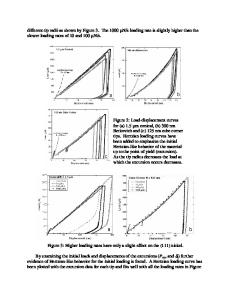Effects of elastic strain and diffusion-limited aggregation on morphological instabilities in sputtered nitride thin fil
- PDF / 712,632 Bytes
- 10 Pages / 584.957 x 782.986 pts Page_size
- 12 Downloads / 322 Views
Mamidipudi Ghanashyam Krishna School of Physics, University of Hyderabad, Hyderabad 500 046, India; and Centre for Nanotechnology, University of Hyderabad, Hyderabad 500 046, India
Kuppuswamy Anantha Padmanabhan Centre for Nanotechnology, University of Hyderabad, Hyderabad 500 046, India; and School of Engineering Sciences and Technology, University of Hyderabad, Hyderabad 500 046, India (Received 26 February 14; accepted 5 August 14)
The nature of morphological instabilities in sputtered titanium and niobium nitride thin films grown on amorphous borosilicate glass and single-crystal Si (311) substrates is investigated. All the films were grown by RF magnetron sputtering at constant power and pressure but with thickness varying from 40 to 400 nm and substrate temperatures of 250–300 °C. The surfaces of the thin films can be divided into two areas: one in which the morphology is smooth with densely packed grains and the other in which there are morphological instabilities. A closer observation of the morphological instabilities reveals the coexistence of elastic strain-induced Asaro–Tiller– Grinfeld (ATG) type of instability and dendritic and snowflake structures due to diffusion-limited aggregation (DLA). The ATG instabilities extend over lengths of several tens of micrometers, whereas the DLA structures are confined to lengths of less than 10 lm in the same film. At low thickness (40–100 nm) only the elastic strain-induced instabilities emerge. High growth rates and a thickness of 150 nm are required to cause DLA and coexistence of the two kinds of instabilities. It has also been found that crystallization is not a prerequisite for the formation of dendritic structures.
I. INTRODUCTION
It is known that the physical and chemical properties of thin films are strongly dependent on the morphology, i.e., the size and shape of microstructural features.1 Thin films grown by physical vapor deposition exhibit several morphologies due to self-assembly or kinetically driven surface structures. Under nonequilibrium growth conditions, anisotropic surface diffusion and kinetic roughening have been shown to lead to surfaces with asymmetric shapes, where thermodynamics and kinetics play competing roles in determining the film morphology. Strain is an important factor that is frequently encountered in thin films grown on noncoherent substrates. The strained layers are inherently unstable and undergo morphological changes by strain relaxation. Both modeling2 and experimental work3 suggest that depending on the interplay between elastic or plastic strain relaxations, misfit dislocations at a)
Address all correspondence to this author. e-mail: [email protected] b) Present address: Chemistry and Physics of Materials Unit, Jawaharlal Nehru Center for Advanced Scientific Research, Jakkur, Bangalore 560064, India DOI: 10.1557/jmr.2014.221 J. Mater. Res., Vol. 29, No. 16, Aug 28, 2014
http://journals.cambridge.org
Downloaded: 15 Sep 2014
the interface or strained islands on the surface are formed. Furthermore, evidence for strain relaxation in
Data Loading...











